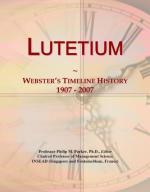|
This section contains 353 words (approx. 2 pages at 300 words per page) |
Lutetium is an element that belongs to the lanthanide group. Its atomic symbol is Lu, its atomic number is 71, and its atomic weight is 174.967. The metal has a melting point of about 3,025.4°F (1,663°C) and a boiling point of 6,155.6°F (3,402°C). It is a soft ductile solid, with a silvery-white luster. It occurs in the Earth's crust to the extent of 0.8-1.7 parts per million. While that seems like a very low concentration, it is greater than the abundance of cadmium, mercury, iodine, and some other better known elements. Yet, there is little commercial demand for lutetium because it is difficult to prepare as a pure metal, and relatively little is known about the element and its compounds.
The explanation for this dichotomy is that lutetium does not occur in concentrated forms in specific locations, as do the elements mentioned above. Further, the minerals in which it does occur contain far larger quantities of other rare earth elements. And the problems of separating the rare earths from each other are well known.
In fact, lutetium was among the last rare earth elements discovered. In 1902, Georges Urbain (1872-1938) showed that the compound called ytterbia, then thought to be an oxide of the element ytterbium, was actually a mixture. He named the two parts of the mixture neoytterbia (for "new ytterbia") and lutecia. Urbain selected the name lutecia in honor of the Latin name of his native city, Paris. In 1949, the official name of the element was changed to lutetium.
Karl Auer von Welsbach (1858-1929) was conducting similar studies on ytterbia in Germany at about the same time, with similar results. He called the two factors of ytterbia cassiopeium and aldebaranium. Charles James (1880-1926), at the University of New Hampshire, made similar discoveries, but announced his results somewhat later.
Elemental lutetium can be prepared, with considerable difficulty, by heating anhydrous lutetium (III) chloride or fluoride with an alkali or alkaline earth metal, such as sodium, potassium, or calcium. Except for some applications as a catalyst in the petroleum industry, neither the element nor its compounds have many commercial applications.
|
This section contains 353 words (approx. 2 pages at 300 words per page) |


